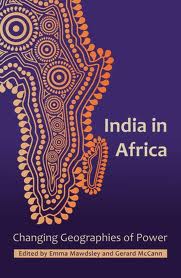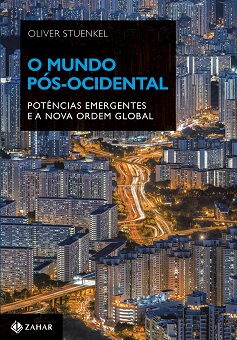
This highly informative collection of essays edited by Emma Mawdsley and Gerard McCann provides the reader with an excellent overview of India’s presence in Africa – a topic neglected by most books on Indian foreign policy (with the notable exception of Jacob’s and Chandran’s India’s Foreign Policy- Old Problems, New Challenges, which includes a short chapter on the issue). While the topic of China’s growing presence in Africa has long reached the mainstream media, India’s role is largely unknown outside of a small but growing circle of specialists. As the editors recognize in the introduction, “China is certainly a more potent player in most African countries and sectors than India at present, so in part this very uneven interest simply responded to an accurate assessment of their relative material powers and impacts” – at the same time, India’s influence in Africa is set to increase and it holds valuable lessons for other emerging powers active in Africa, namely Brazil and Turkey.
What the authors make clear early on in the book is that while international observers have a negative bias when analyzing China’s role in Africa, India is often portrayed as overly positive – for example, China was roundly criticized and shamed publicly for its ‘irresponsible hydrocarbon investments’ in Sudan, but few realized that India – behaving just like China – was not subject to the same scrutiny. As Sanusha Naidu writes in chapter 3, India is comfortable operating in China’ s shadow, although it is unclear for how long India can escape the criticism for such controversial moves such as large-scale farm acquisitions and subsequent near duty-free food exports of crops to India.
Is India’s role comparable to that of China? Are China and India engaged in a new version of the ‘scramble for Africa’? In Chapter 1, Fantu Cheru and Cyril Obi argue that contrary to official Indian rhetoric, India’s and China’s interests in Africa are simply too similar to avoid competition. They say that
It is important to note that when stripped of its rhetoric, it is hard to ignore the similarities between the African strategies of India and China, which is found in ‘their demands for resource security, trade and investment opportunities, forging of strategic partnerships, African–Asian solidarity and South–South solidarity’.
Instead, what differentiates India’s role in Africa is its smaller dimension, later entry and, due to financial constraints, the necessity to engage with economic blocs such as ECOWAS (rather than governments) and to bet on a more dynamic private sector to strengthen India’s presence. This does not mean that trade is the only driver of India’s engagement – as the authors point out, particularly the East African coast is of great strategic importance as India seeks to build a visible presence in the Indian Ocean, and the Indian navy regularly conducts naval patrols off Mozambique’s coast.
While the common assertion that China’s presence in Africa follows a centrally planned master plan designed in Beijing is not correct (as Deborah Brautigam points out in her excellent book on China’s presence in Africa), it is true that India’s engagement with Africa seems more uncoordinated that China’s. In a way, this is unsurprising, as India’s “private-sector driven, unplanned, polarizing and chaotic model of economic development” is, quite naturally, in evidence in Indian economic relations with Africa.
In Chapter 2, Pádraig Carmody correctly notes that Africa has a much greater strategic importance for India than for China, particularly regarding energy. India possesses less than 0.5% of the world’s proven oil reserves, and it is expected to run out of coal over the next decades, which will force it to import virtually all of its energy – and in order not to become overly independent on a perennially unstable Middle East, India, soon the world’s third-largest energy consumer, will increasingly import African oil.
As there are more poor people in India than in all of Africa combined, and as Africa’s average GDP is $200 higher than that in India, the motivation for India’s increasing aid payments can be better explained by economic and political motivations rather than by humanitarian ideals – aid is seen as a tool to boost India’s soft power and reduce Africans’ fear that India is primarily interested in exploiting Africa’s resources. At the same time, Africa’s support for India’s campaign for a permanent UN Security Council Seat is indispensable, even though the clear date for the next attempt to bring about reform has not been set.
Chapter 6 by Gerard McCann is particularly enlightening as it questions the common wisdom that India’s historic diaspora in East Africa provides Indian companies with a competitive advantage. He even argues that in a highly ethnicized political economy like Kenya’s, the long presence of Indians would pose obstacles to the arrival of the new generation of Indian companies, like Bharti Airtel, writing that “it seems that laudatory rhetoric about historical friendship, at times, obscures tensions between various African and Indian actors.” And he shows that African-Indian relations have by no means been problem-free – in 1962, for example, Kenya’s political leadership openly supported China during the Sino-Indian War, despite the presence of the Indian community in Kenya. In the 1990s, the high profile complicity of Indians in Moi’s kleptocratic regime compounded prejudice in Kenya against the Indian community.
Chapter 9 by Luke Patey details India’s OVL’s entry into Sudan, benefitting from Western oil firms’ decision to exit the country due to growing insecurity and international pressure from human rights organizations. What is particularly interesting here is that the Indian government (which owns much of OVL) was much less concerned about human rights abuses then about losing its investment due to the unpredictable political situation in Sudan.
In Chapter 10, Emma Mawdsley analyzes the theoretical and philosophical underpinnings of aid, comparing ‘traditional Western aid’ to ‘South-South cooperation’ – while such a distinction is difficult to make in the real world (as the author acknowledges), this chapter is useful for academics (rather than policy makers). She concludes that
Southern donors actively attempt to avoid this discursive positioning (of donor vs. recipient) of their development cooperation: something that many western donors could learn from. But just like western donors, southern development partners are in pursuit of their own interests, and their symbolic claims should be equally subject to critical evaluation as those of the western donors.
The authors frequently note how limited our knowledge of India’s role in Africa is- effectively complicating the Indian government’s capacity to pursue an informed Africa policy. From a Brazilian point of view, such arguments should cause alarm bells to ring, for Brazil possesses virtually no systematic knowledge at all about the role it plays in Africa. In order not to make avoidable mistakes (that China has made by sometimes appearing like a threat to Africa), Brazilian academics must undertake a greater effort not only to provide big-picture analyses, but to spend time on the ground and collect meaningful and measureable data. For Brazil, Africa will soon be about much more than business opportunities, South-South solidarity and the collection of support in the UN General Assembly for a permanent seat in the UN Security Council. As Alex Vines points out in Chapter 11, Africa will be of great strategic importance – this is particularly true once the new generation of large container ships can no longer pass through the Suez Canal, and need to take the route around the Cape of Good Hope – an area where Brazil will have to exert control if it seeks to position itself as a global power.
The book is thus extremely useful for those seeking to gain a better understanding of India’s presence in Africa. Brazilian Africa scholars could equally benefit from it. Brazil is trailing both China and India in Africa, but if it studies China’s and India’s role in Africa carefully, it can avoid their mistakes and engage Africa more effectively. Otherwise, the red carpet rolled out to welcome Brazil to the continent, “will quickly be rolled up and taken away.”
Read also:
Book review: “India’s Foreign Policy: Retrospect and Prospect” by Sumit Ganguly (ed.)
Book review: “The First Great Realist: Kautilya and his Arthashastra” by Roger Boesche








